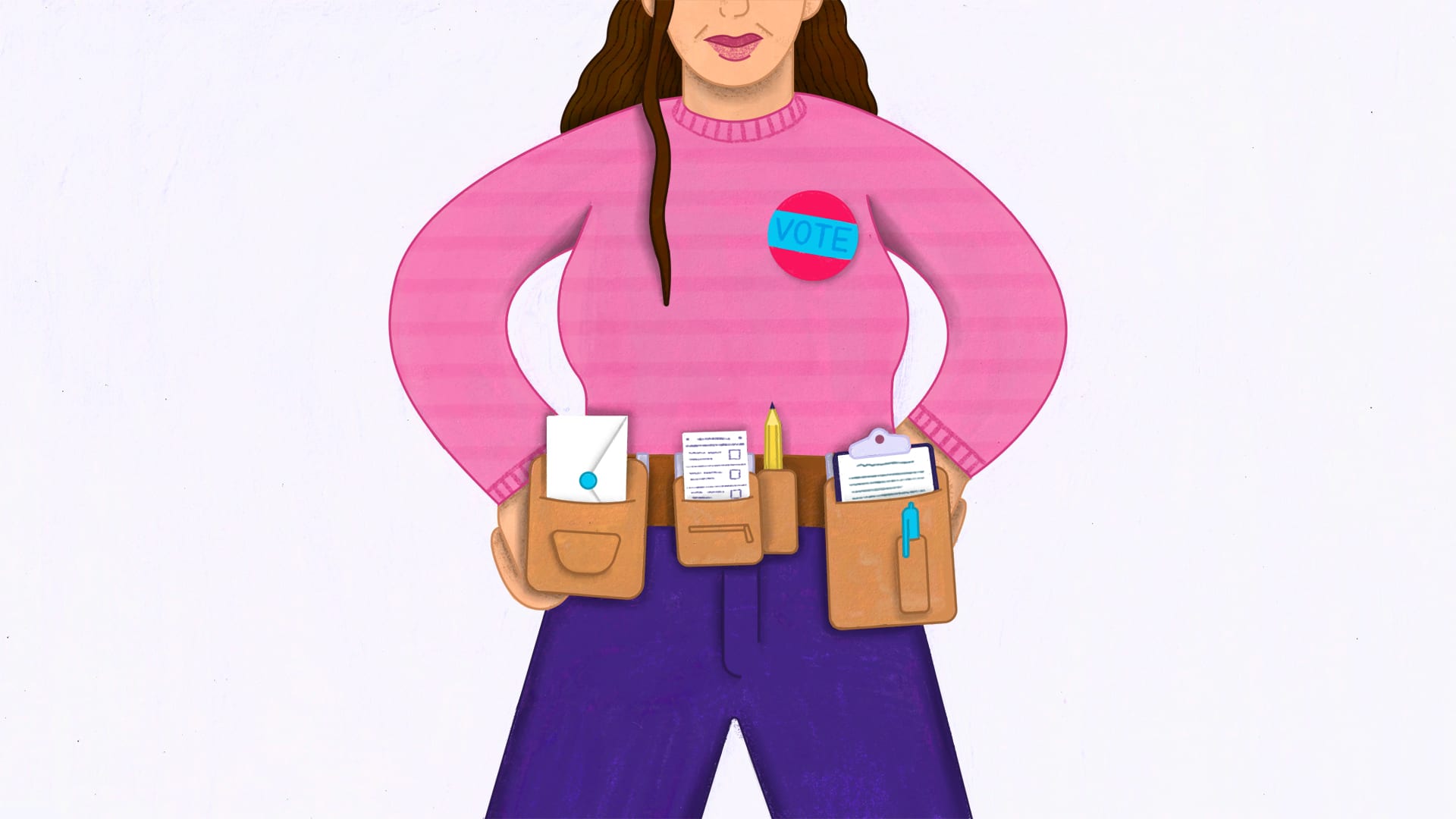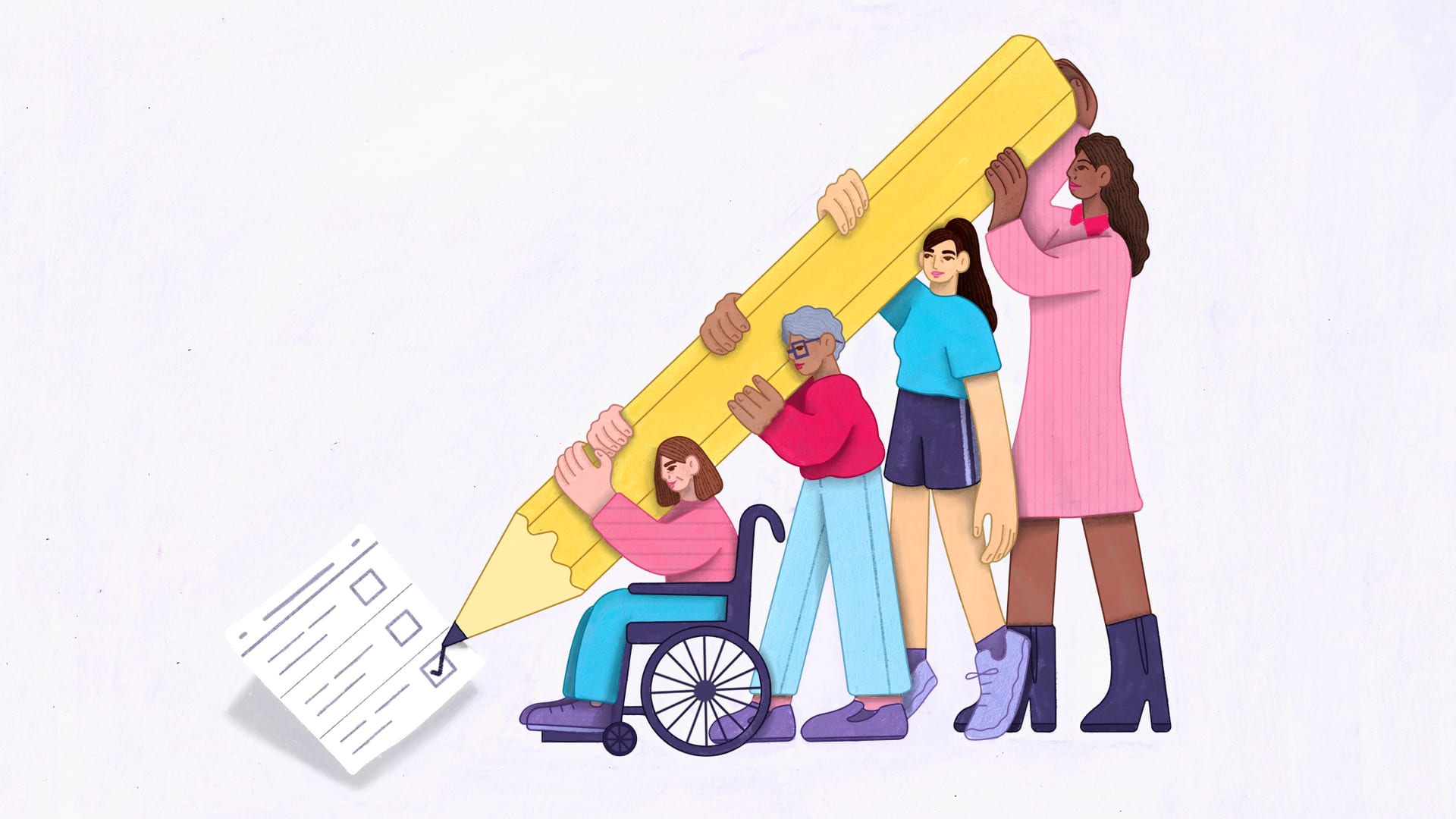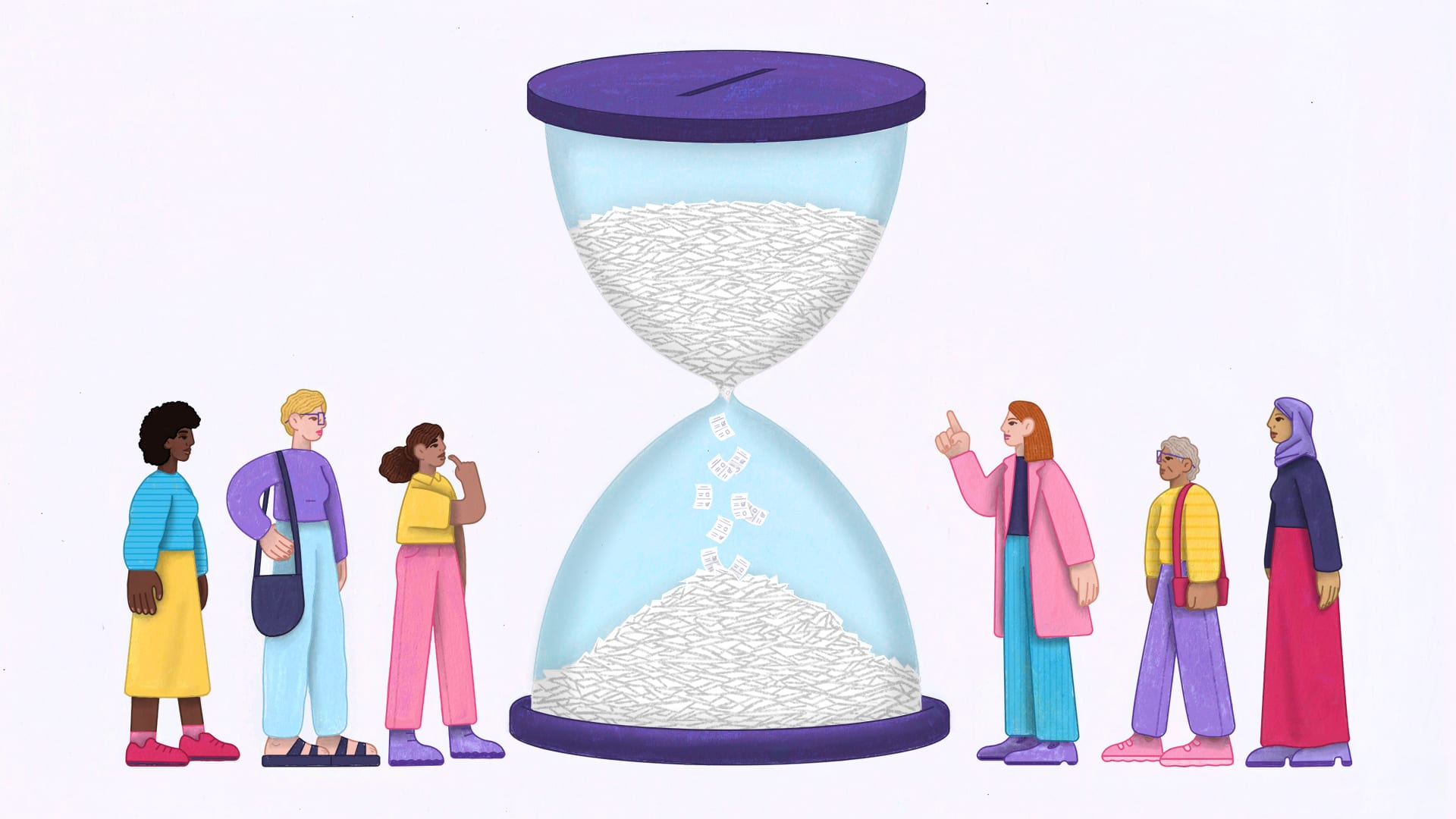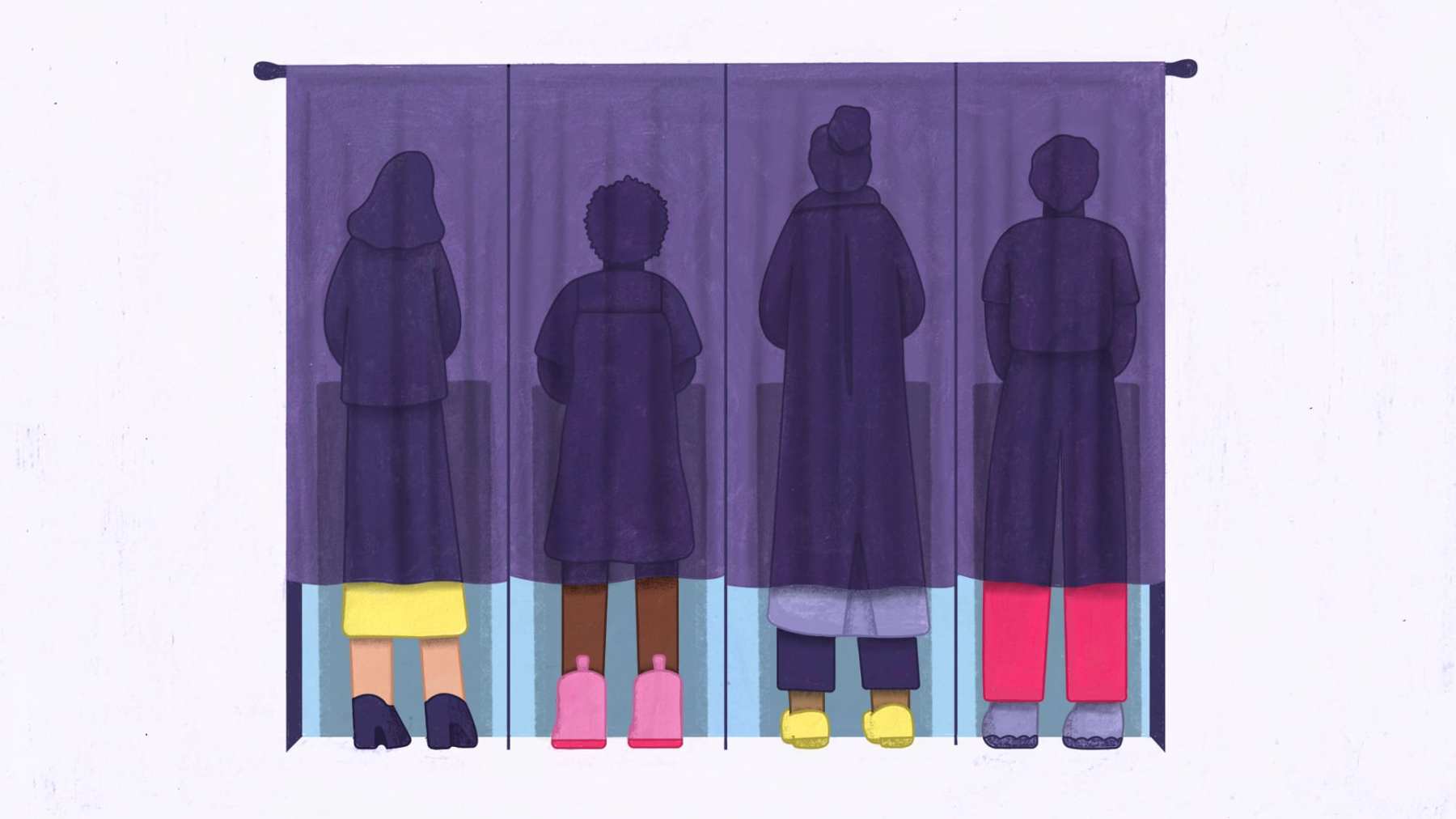Long lines due to expected record voter turnout amid a global pandemic. Ongoing concerns about online misinformation. Hundreds of lawsuits over voting, some of which could reach a more conservative U.S. Supreme Court. Poll workers facing changing election rules. An incumbent president who won’t guarantee a peaceful transfer of power.
In the lead-up to the November 3 election, there is an unprecedented onslaught of election-related news. At the center is President Donald Trump, who continues to lie about the overall security of mail-in voting and preemptively cast doubt on election results. He has claimed without evidence that there could be rampant voter fraud during the election.
“He’s gaslighting and lying for a reason,” said Jena Griswold, the Democratic secretary of state in Colorado, about the president. “He’s trying to tilt the election in his favor by either suppressing voters, suppressing access or adding so much confusion that people just throw up their hands and don’t vote.”
Kim Wyman, the Republican secretary of state in Washington, home to one of the first comprehensive vote-by-mail systems in the country, said voters are being inundated with information.
“It’s overwhelming. If you try to take on all of it … it’s too much,” she said. “So you have to focus on the things you can control.”
There are nearly daily developments adding potential wrinkles in the process. In the final days before the election, Republicans in key battleground states have sought court rulings that would limit election officials’ counting of mail-in ballots that were sent in before or on Election Day but arrive afterward. The scope of those requirements depends on the state.
So what does it all mean for you as a voter? What should you do and expect before, during and after Election Day? Secretaries of state, often the statewide voting administrators, and voting experts offer their advice for how to prepare and what to watch for.
Before Election Day

What do I need to do to prepare to vote?
Make a plan for casting your vote, whether that’s by mail (or dropbox), early in-person voting or heading to the polls on Election Day.
America’s decentralized elections system means every state has a different set of laws and rules (in some cases, amended ones in direct response to the coronavirus) outlining how and when its residents can vote. Familiarize yourself with the specific requirements and deadlines for your state and make a plan about your voting method, said Kat Calvin, founder and executive director of Spread the Vote, an organization that helps people obtain identification cards required to vote in several states.
“You need to make a plan about each and every step, so that you can then make sure that you are actually following all the steps you need to vote,” she said.
What else should I do before casting my ballot?
Other straightforward questions that experts want voters to ask:
- Are you registered to vote and is your address up-to-date?
- If you’re voting by mail, have you requested your ballot?
- What is the deadline for requesting one and turning it in?
- Where can you drop off your ballot (if applicable)?
- If you’re voting in person, do you know where your polling place is located? And are you sure it hasn’t been closed or moved because of the pandemic?
- Do you need identification to vote?
- Are you prepared to wait several hours in line if there is high voter turnout?
Jocelyn Benson, the Democratic secretary of state in Michigan, said her staff has been working to ensure voters understand their options, and communicate that the process will take time. But it doesn’t mean anything is amiss.
“We will continue to remind people that a vote is a vote is a vote,” she said. “Whether it’s voted early or whether it’s voted by mail or whether it’s voted in person on Election Day. And the person who is the ultimate victor in an election is the person who wins the majority of the entire collection of votes.”
During the election

When should I vote?
Experts strongly encourage people to vote before Election Day if possible, whether that’s by mail or in person. People are taking the advice: Early voting has already shattered records in several parts of the country. As of late October, more than 80 million people had either voted in person or returned a ballot through the mail, a dropbox or elections office.
Is it safe to vote by mail?
Overall, experts say that vote-by-mail is safe and reliable.
Voting by mail (also known as absentee voting; the terms are often used interchangeably because both typically involve ballots being sent through the mail) is expected to increase dramatically compared to previous years because of the pandemic.
Amber McReynolds is CEO of the National Vote at Home Institute, which works to expand vote-by-mail systems across the country.
“What vote-by-mail does is it takes stress off of Election Day, and off of voters, from having to wait in line a really long time, or face other challenges,” she said. “I have a slideshow I give a lot to people, where I include all the headlines that we’ve seen every two years, every election cycle: Machine malfunctions. Long lines. Provisional ballots running out. People showing up at the wrong polling place. It’s the same issues over and over and over.”
Benson estimated more than 3 million people in Michigan will vote by mail in the general election, an increase from 1.6 million in the primary. One week before Election Day, 2.2 million people in the state had returned absentee ballots.
Benson expressed confidence in the state’s protocols for receiving and processing mailed ballots.
“The bottom line is in Michigan we have a secure process for voting by mail. It’s built with time-tested security protocols that have stood the test of time in states all across the country, from signature verification to barcodes that track ballots everywhere they are,” she said. “So I’m very confident in the security of our process, but our challenge certainly is making sure our citizens feel confident in it.”
Some states have had years to perfect their vote-by-mail systems while others, after approving emergency rules, have scrambled to catch up in a few short months and with limited resources. That has led to problems. During the lengthy primary season, there were reports in places like D.C., Georgia and Wisconsin of people never receiving their absentee ballots.
This summer, reports of delays in the U.S. Postal Service led to public and congressional scrutiny. The newly installed postmaster general, Louis DeJoy, later backtracked on proposed cost-cutting operational measures. In September, a federal judge ordered a temporary block of any USPS changes ahead of the election.
Other glitches have popped up. A printing error led some New York City residents to receive incorrect return address information on their ballots. In Georgia, election officials had to implement software fixes for new voting machines.
McReynolds said election officials around the country have taken their commitment to improvements seriously after the primary, adding that New York City has a history of problems with its election system.
“No election process is perfect. It’s run by people. There’s a lot of moving parts,” she said. “Are we going to see issues come up? Yes, and every election cycle, issues come up.”
What is absentee voting?
Absentee voting: Traditionally, it has meant being “absent” from voting at a polling place or election official’s office on Election Day. The ballot sent to the voter is called an absentee ballot, and the person who receives the ballot is an absentee voter.
All-mail voting: This highlights that in some states, a ballot is automatically mailed to every eligible voter whether or not they request one. Some of these states still make in-person voting available.
The terminology has evolved over the years as more states expand voting options and people vote before Election Day. Some states refer to the additional options as “advance ballots,” “mailed ballots,” “by-mail ballots,” “mail ballots” or “vote-by-mail ballots.” The National Conference of State Legislatures uses the term “absentee/mailed ballots” to reflect the traditional terminology and its evolution.
Calvin added that it will be critical for voters to accurately read the instructions on their mail-in ballot when filling it out. Incorrectly filled out ballots can lead them to be rejected. In Pennsylvania, a recent court ruling would invalidate ballots that aren’t placed in secret envelopes. More than 550,000 ballots around the country were rejected during the primary, according to an NPR analysis.
“Do everything that you can do to be sure that you and your friends and family are voting, and voting accurately and correctly, and then just sit down and wait,” she said. “It’s a boring message. You just have to wait. I’m sorry. Calm down. It’s not sexy, but too bad.”
What if the ballot is delayed?
In mid-September, people in Virginia waited several hours on the first day of early in-person voting to cast ballots. Some reported that they showed up because their absentee ballot had not yet arrived in the mail.
Irene Shin, executive director of Virginia Civic Engagement Table, said it’s important for voters to educate themselves on the rules in their states around voting. In the case of Virginia, the first day of early in-person voting was also the first day that mail-in ballots were slated to be delivered to homes.
“When early voting started, a bunch of folks showed up to their election offices or to the registrar’s offices and were like, ‘I never got my ballot, now I have to vote in person.’ And they’re like, ‘Great, can you just go home and sit tight?’” she said.
The option to vote by mail is complicated as the clock winds down to Election Day. By late October, if you haven’t received a requested ballot, visit your local elections office to vote early in person if possible. Secretaries of state in battleground states like Arizona and Florida suggest if you have have your absentee ballot but have yet to mail it back, fill it out but return it in person instead because otherwise it may not be counted.
In late October, the U.S. Supreme Court ruled on several lawsuits in key states that could have an impact on who wins the presidential election. The court refused on October 26 to hear a case out of Wisconsin that would have extended the state’s deadline for accepting mail-in ballots.
Days later, the court issued rulings that effectively extend absentee ballot counting deadlines in Pennsylvania and North Carolina. Justice Amy Coney Barrett, who was just confirmed to the court in a highly partisan fight in the U.S. Senate, did not participate in the rulings.
What about in-person voting?
Calvin said if people insist on voting in person — or, in the case of some states, there is no option to vote by mail — they should do so before Election Day if possible.
Voting early means people are more likely to be able to address potential issues that may arise with their ballot (a forgotten ID during early in-person voting, or a rejected mail-in ballot because of signature verification).
“There’s no reason not to vote early, particularly this year,” Calvin said. “…It’s the best way of ensuring that you’re actually able to vote.”
McReynolds expects “unprecedented” voter turnout, potentially leading to longer lines than usual on Election Day. The pandemic is also expected to impact the number of available poll workers, and election officials will also be implementing social distancing measures and other safety precautions (like periodic cleaning at polling locations) that could further increase in-person voting lines.
“We are already seeing the highest interest we’ve ever seen in a presidential election, and there’s going to be a lot of voters that have never voted before that will participate for the first time, whether they’re new and young voters or they just only participate in presidentials,” she said. “If you wait until the last minute, there’s likely going to be long lines on Election Day.”
But just because things look different this year doesn’t mean anything is amiss. Griswold, Colorado’s secretary of state, said she was alarmed that the president has encouraged supporters to show up at polling places on Election Day to watch voters. She noted states have laws in place on how people can become poll watchers, but she felt the president’s framing could be interpreted to go beyond that legal process and into the territory of voter intimidation, which is a federal crime.
“If you go through the program and you are a certified poll watcher, by all means go to the polls. We have bipartisan poll watchers through every step of our election process. We also have bipartisan judges and election workers, and they’re key to the process,” she said. “But what we won’t accept is voter intimidation. And if the president is urging, whether it’s his supporters to neo-Nazis, to disrupt or try to suppress the vote, we will take immediate action.”
After Election Day

When will we know the election results?
For decades, there has been a tradition in American politics and media of top television networks calling the presidential race on election night after the polls close. Those expectations must change, said Wyman, the Washington secretary of state.
“In some ways, as a country, we go back to this notion that we had in 1960, that we’re going to know election night who won, because ABC, CBS and NBC are going to tell us,” she said. “Now you fast forward to 2020. We have far greater numbers of ballots and voters to deal with and to serve,” she said.
There is a growing expectation among voting experts that Americans will not know who won the presidency even in the days (or weeks) that follow. It’s important to get voters to accept that reality now, said Benson in Michigan. She expects to finish counting ballots in Michigan by the Friday after Election Day.
“There’s going to be a lot of people who may be accustomed to getting results as soon as the polls close, who are wondering why it’s taking perhaps longer this year than in other years,” she said. “But it’s incumbent upon all of our states’ chief election officials to make sure that voters know exactly what is happening in every step of the process.”
Wyman notes that the timeline must account for battleground states counting ballots — both mail-in and in person — as well as potential litigation (there are more than 200 election lawsuits and counting tied to the coronavirus).
“At the end of the day, the only thing that matters is those ballots that are counted by eligible voters and that’s what’s ultimately going to decide the president,” she said. “I think it’s going to be late. I think it’s going to be mid to late November, before we are absolutely certain.”
When can states count mail-in ballots?
States have different rules around when its election officials can begin processing mailed ballots. The ability to process mailed ballots ahead of Election Day allows for quicker results when in-person polls close.
Some states, like Florida, Arizona and North Carolina, allow election officials to process ballots ahead of Election Day. Many others, including the major battleground state Pennsylvania, can only begin processing them on Election Day.
Recent U.S. Supreme Court rulings also show the evolving instructions around postmarked ballots in the mail. Although it will in some instances expand the number of people who will have their ballots counted, it also means election officials in those states are expected to be counting ballots several days after Election Day.
Separately, an influx of new voters who turn out on Election Day could lead to a jump in provisional ballots. Those are the last batch of votes counted, and in a close election, could be key.
“We need to be patient,” McReynolds said. “We need to give election officials the space and the time they need to get it right. Because we want to make sure it’s accurate, more than anything.”
Benson said it’s important for people to understand that the process is playing out the way it’s supposed to (there has long been a legal process for certifying election results). Just like a baseball team can’t declare victory in the fourth inning, she said, neither can a candidate or campaign without complete results.
“Truth is truth and democracy is democracy,” she said. “And so our work, and really we hope the work of so many others, is going to be to lay the truth at our side, ensure that citizens know, that the public knows, what actually determines the victory in any particular political campaign or race.”
What does that mean for the results?
The large number of expected mail-in ballots, coupled with a required hold until Election Day in some states on processing them, means some battleground states will have results before others.
Hawkfish, a Democratic data and analytics firm funded by Michael Bloomberg, predicted a “red mirage” on election night. It crunched available data to suggest that Trump could appear to be winning in a landslide that night with incomplete results, only for that lead to dissipate as mailed-in ballots are counted. Polls indicate Democrats are more likely than Republicans to vote by mail this year.
Separate election experts have disputed the scope of the firm’s landslide prediction, but agree early returns could show Trump ahead.
Those are ripe conditions for misinformation to spread. Trump himself has made recent baseless claims on Twitter and at rallies about the integrity of the election system. He has also cast doubt on election results.
“We want to make sure the election is honest, and I am not sure that it can be,” he said on September 24 from the White House lawn. “I don’t know that it can be with this whole situation of unsolicited ballots.”
Trump has continued to lie about voter fraud. In early September, Trump encouraged supporters in North Carolina to vote twice, by mail and in person, a felony in the state. In late October, Trump claimed without evidence that there are “big problems and discrepancies” with ballots that have been mailed in, a declaration that led Twitter to flag the post as disputed or misleading.
Trump has also claimed without evidence that it could take months or years to know who won the election results (this is not true; there are legal provisions that will trigger deadlines on deciding who won by January. The U.S. Supreme Court ended a Florida recount vote in the presidential race between George Bush and Al Gore in December 2000).
Is there a real danger of voter fraud?
There are few cases of fraud in states that have expansive vote-by-mail systems where millions of ballots have been counted. States also have tools to protect election integrity with mail-in ballots. McReynolds said the threat of people sharing inaccurate information, whether intentional (disinformation) or not (misinformation), is her biggest concern going into the election.
“When you scare people or change people’s minds with bad information, that’s worse than hacking a system. If a system were hacked … we can identify that in an audit. If you change people’s minds through misinformation and disinformation, confuse people, decrease their trust in the process because of that information, that’s the most destructive type of warfare.”
The process of certifying elections — the finalizing of election results, conducted by officials in each state — has always taken weeks depending on the individual state. The influx of mail-in ballots amid potential litigation over rejected ballots means it will be a closely watched set of events, but not one that is unusual.
There are key dates after this to track:
- December 8: State recounts and litigated contests over election results must be completed.
- December 14: Electors (representing each state and the District of Columbia) meet and cast ballots for president and vice president.
- January 6: The new U.S. Congress meets in joint session to count the Electoral College votes. Shortly after, according to the U.S. Constitution, a president is sworn in.
There are additional what-ifs in those post-election timelines. Wyman is focused on the now, which means consulting with secretaries of state over their vote-by-mail systems. She has encouraged officials to have security controls in place to prevent voter fraud, and to ensure election staff have the capacity to consistently handle a high volume of mail ballots.
Wyman, asked what she would say to voters if seated next to them on Election Day, held back tears. An election official for at least two decades, she called democracy “messy.”
“Even the framers didn’t intend for it to be an easy process. Civic engagement is not easy,” she said. “But it’s part of why our country has been around for over 200 years.”
Wyman said it’s important for people to trust the institutions that will determine the election.
“We have to respect and believe in the process,” she said. “And we ultimately have to remember that … our country is fragile right now, and that it’s easy to throw something out on social media. And just because someone throws out something, it doesn’t make it true, and doesn’t make it right.”






